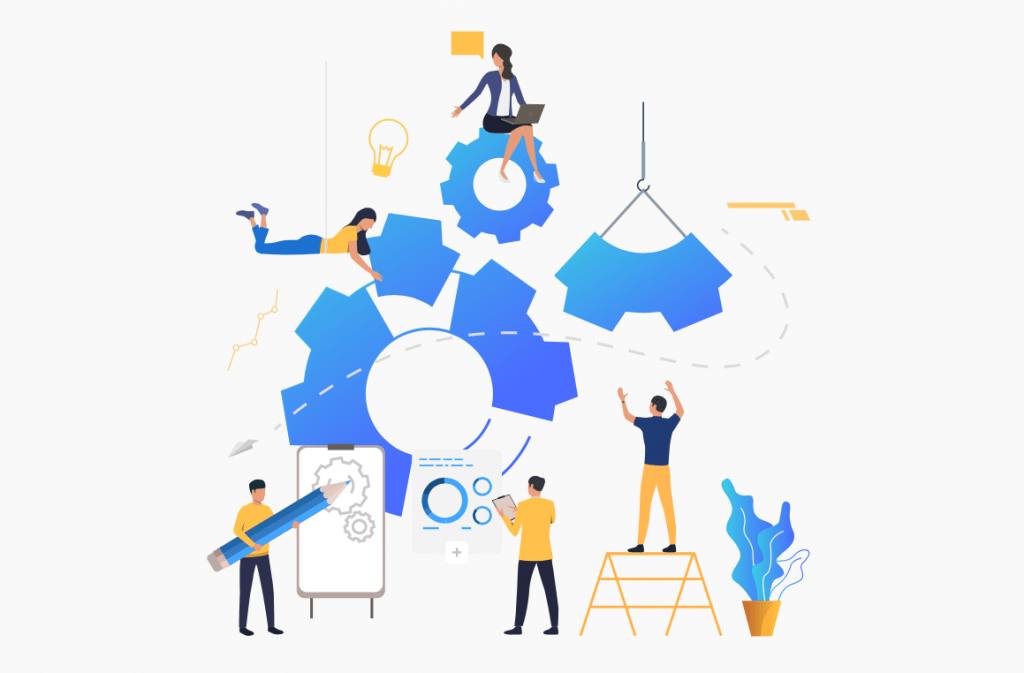Firms use AI tools to an increasing extent. These technologies are gaining importance both in strategy work and in operations. We need to consider both to understand how AI is changing the dynamics of strategizing.
AI tools can be directly used in strategy work. For instance, AI tools could bring fresher and more relevant information to support decision-making. Or they could enable new ways to model and simulate potential scenarios.
However, the use of AI tools in operations has critical strategic implications as well. AI in operations changes the context of strategizing. Carefully consider the consequences as AI seeps into broader use within your company.
AI tools can take over aspects of the middle managerial role
The need for middle managers has been, in turn, questioned and defended in the past few decades. The latest punch comes from the promise of AI. Some, again, argue that middle managers will disappear. However, we don’t have to go this far to see the middle managerial post is changing.
Evermore complex decisions are more and more data-driven, even automated. And optimizing (of production or computing capacity, for instance) can be done in real-time. For example, Relex provides solutions for optimizing and automating inventory management.
So how exactly is the middle managerial role changing? And what does that mean for the dynamics of strategizing?
Middle managers have several strategically important roles
Middle managers have a number of strategically essential roles. First, middle managers transform strategy into everyday action.
Second, middle managers collect, synthesize, and report information. Doing so, they influence what top management pays attention to.
And finally, middle managers spot and champion new projects. In this role, they affect the future direction of strategy.
Let’s consider how AI tools might change the dynamics in each of these roles.

1 AI puts your strategy to practice – What you optimize for is what you get
Middle managers bring strategy to life through daily decisions, communication, and leadership. In doing so, they can be a vital force of change. Or they can be a stubborn source of change resistance.
Strategy comes to life through decisions and interactions
Strategy, by its nature, is both abstract and opaque. It offers broad guidelines rather than an instruction manual. And it comes to life in daily decisions and encounters, at managerial discretion.
Middle managers use their judgment, always affected by political and emotional circumstances, to implement decisions. They can find the most effective way to balance change and continuity. They can spot potential problems and course-correct.
Or they can resist change and hinder implementation if they see it as a personal threat.
AI tools execute your strategy
AI tools won’t question your strategic direction any time soon. Hence AI-enacted strategy can mean lessened change resistance, faster implementation, and more consistent execution.
But it also means that you lose the reflective layer between you and your firm. A layer that can course-correct when direction seems off. A layer that can tailor the approach appropriately for each circumstance. Getting it right, in a sense, thus becomes much more critical.
AI tools can pick up external signals
However, AI tools could also pick up external signals and learn. And this could potentially diminish the role of strategy. Just start with some initial parameters and let the technology find the most profitable way forward. On a smaller scale, one example of this is Smartly.io. Their ML-based tools can boost marketing optimization by automatically allocating budgets.
Yet, it is not likely that AI tools could autonomously find disruptive change. They might even work against it if future product niches seem less profitable in the short term.
Know what you optimize for
When decisions start to lack human reflection, you need to be mindful of what you are trading it for. It can be a road to the efficient execution of your defined strategy. Or it can lead to a largely data-driven business that doesn’t need a strategy, as we understand it today, at all.
It is essential to understand what this leads to. A good start is to stay close to algorithm development. Further, include expertise from all levels of the firm in this effort. This helps to capture the changing role dynamics. And check these posts on AI adoption and AI transformations for more tips.
Know what you optimize for, as for better or for worse, it is what you will get.
2 AI alters the flow of information – Pay attention to what you pay attention to
Middle managers are also a vital source of information. They collect, synthesize and report intel to top management. The introduction of AI tools is likely a double-edged sword for what comes to the flow of information.
First, these tools are likely to enable top management greater access to data. But then again, such tools might lessen the amount of middle managerial insight.
Top management could get access to more structured data
With the increasing amount and freshness of data, managers could get a more clear picture of operations. For AI to make decisions, large amounts of structured data need to be available. And when this data is available for the AI, it is available for the management as well.

For example, dashboards can show real-time data on many aspects of the business, such as sales volumes, risks, or new trends. With more of the relevant data captured and codified, the information advantage of middle managers could lessen.
AI and middle managers guide top management attention – in different ways
#nofilter. When accessed through tools, top managers see what there is rather than what middle managers want them to see.
For instance, a firm we have studied developed a tool for streamlining reporting. This tool gives managers, in addition to an overview, detailed data on project execution. Instead of relying on curated views, they can get to the nitty-gritty if they so choose. This approach has changed both the how and the what of reporting.
However, AI tools are likely to guide attention in some way as well. These tools can mainly access codified, structured data that the firm has access to. As such, they could be likely to show more data regarding existing products and markets.
Such focus can steal the spotlight from more distant opportunities. A constant flow of incremental improvement opportunities, while helpful, might distract you from the abrupt change.
Effective data interpretation requires diverse perspectives
And finally, strategic problems are not simply about data crunching but require insight, thought, and framing. Different levels of management could make diverse interpretations based on the same data.
Top and middle managers are likely to have different cognitive frames for data processing. Middle managers closer to the details could notice different things than top management primarily interested in the big picture.
Further, middle managers could have more time to process shifts in trends, whereas top management is often spread thin. As AI takes over tasks, you could lose a synthesizing layer that also debates and sensemakes with you. And this could mean a loss of perspective and weaker information processing.
3 The changing dynamics could hinder seizing new opportunities – Mind what is happening to your middle managers
Middle managers have had a unique position to spot and seize new opportunities.
They are in the details of both the operational and the strategic. Further, they have wide social networks, including top managers, fellow middle managers, and frontline employees. And finally, they maintain boundary-spanning relationships with, for example, customers, suppliers, and partners.
Opportunity seizing is an aspect of the middle managerial role that AI cannot soon replace. Now, managers can use data and tools to notice that a new customer segment is emerging. But it likely requires human oversight to decide to capture such opportunity and to design the plan to do so.
And even less will AI tools champion for and nurture new ideas that hit resistance in the organization. It is thus essential to know what is happening to the middle managerial role. And especially: whether these changes are likely to hinder spotting and seizing new opportunities.

Are your middle managers still operationally relevant?
One crucial aspect of the middle managerial role is their operational experience. Being close to the action enables spotting new options.
However, with increasing automation in decision-making, middle managers risk losing their operational relevance. And with that could go their operational expertise as well.
To mitigate, consider keeping your middle managers closely in the loop with tool development and maintenance. Such co-creation could prevent a potential disconnect between management and operations. Further, it could ensure middle managers have the chance to spot new options.
Do your middle managers still have diverse networks and social capital?
Diverse relationships, in and outside of the firm, allow middle managers to spot ideas.
It could be something a key customer said that later resonates with a discussion with a customer service rep. Or seeing fellow managers battle similar problems again and again. Or maybe it is what a frontline employee is telling them over coffee.
But it is not only spotting ideas. Middle managers can also nurture and champion them. They open doors and enable critical resources while the projects gather momentum. And they utilize their diverse networks and social capital to do this.
Have your interaction patterns changed?
Finally, for middle managers to stay strategically relevant, they need to interact with top management. This interaction is necessary for middle managers to understand the strategic priorities. But it is crucial also for them to be able to exert upward influence. Consider whether and how your interactions with your middle managers are changing.